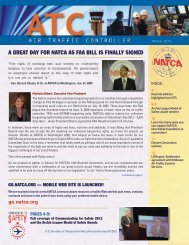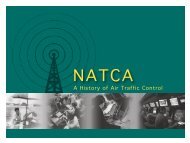Against the Wind - National Air Traffic Controllers Association
Against the Wind - National Air Traffic Controllers Association
Against the Wind - National Air Traffic Controllers Association
Create successful ePaper yourself
Turn your PDF publications into a flip-book with our unique Google optimized e-Paper software.
58<br />
<strong>Against</strong> <strong>the</strong> <strong>Wind</strong><br />
AATCC and <strong>the</strong> NATCA name was dropped.<br />
The darkest cloud overshadowing <strong>the</strong> effort<br />
was money. AFGE membership had plummeted<br />
during <strong>the</strong> early 1980s, creating serious financial<br />
difficulties. In his report, Kushner proposed a conservative<br />
budget of $675,000 to continue organizing<br />
<strong>the</strong> controllers in 1985. He conceded it would<br />
take ano<strong>the</strong>r twelve to fifteen months before AFGE<br />
could expect enough money in dues from AATCC<br />
to cover its costs. Kushner also worried about <strong>the</strong><br />
“shallow support” for <strong>the</strong> effort among AFGE’s<br />
national vice presidents, given its financial constraints<br />
and <strong>the</strong> challenges of organizing a different<br />
Japphire<br />
800 Independence Avenue: In its appeal against petitions for regional unions, <strong>the</strong> FAA argued that it ran <strong>the</strong> air traffic<br />
control system from headquarters in Washington and, <strong>the</strong>refore, <strong>the</strong> new bargaining unit should be nationwide.<br />
1984<br />
2<br />
Nov.<br />
At an AATCC New England meeting, controllers elect Howie Barte from<br />
Quonset TRACON in Rhode Island as <strong>the</strong>ir regional representative. Several<br />
o<strong>the</strong>r regions also have reps by this time: Eastern, Joe D’Alessio, later<br />
type of work force.<br />
The movement at Washington Center, which<br />
began a mere two years after <strong>the</strong> strike, had sparked<br />
regional activity and coalesced into a promising<br />
takeoff. But as AATCC ended 1984 on a tenuous<br />
note, <strong>the</strong> flight toward a national union was in danger<br />
of stalling.<br />
<strong>Controllers</strong> Win a Round<br />
A badly needed victory lifted spirits on February<br />
28, 1985, when <strong>the</strong> FLRA approved <strong>the</strong> New<br />
England petition. The ruling followed three days<br />
of hearings <strong>the</strong> previous November, when <strong>the</strong> FAA<br />
reiterated its objection to <strong>the</strong> proposed single-facility<br />
unions in Atlantic City and Bradley-<strong>Wind</strong>sor Locks<br />
as well as <strong>the</strong> regional unit in New England.<br />
The agency argued that it directed air traffic<br />
operations and employee relations from its headquarters<br />
at 800 Independence Avenue in Washington—not<br />
from its nine regional offices. Therefore,<br />
any union should be national in scope. The FAA also<br />
maintained that automation specialists were part of<br />
management and should not be included in any bargaining<br />
unit.<br />
FLRA Regional Director S. Jesse Reuben partially<br />
agreed and dismissed petitions for <strong>the</strong> singlefacility<br />
unions. But he allowed <strong>the</strong> New England unit<br />
by noting that FAA regional directors “have broad au-<br />
replaced by Joe O’Brien, both from New York TRACON; Great Lakes,<br />
Fred Gilbert from Chicago Center; Northwest Mountain, Gary Molen<br />
from Salt Lake Center.




